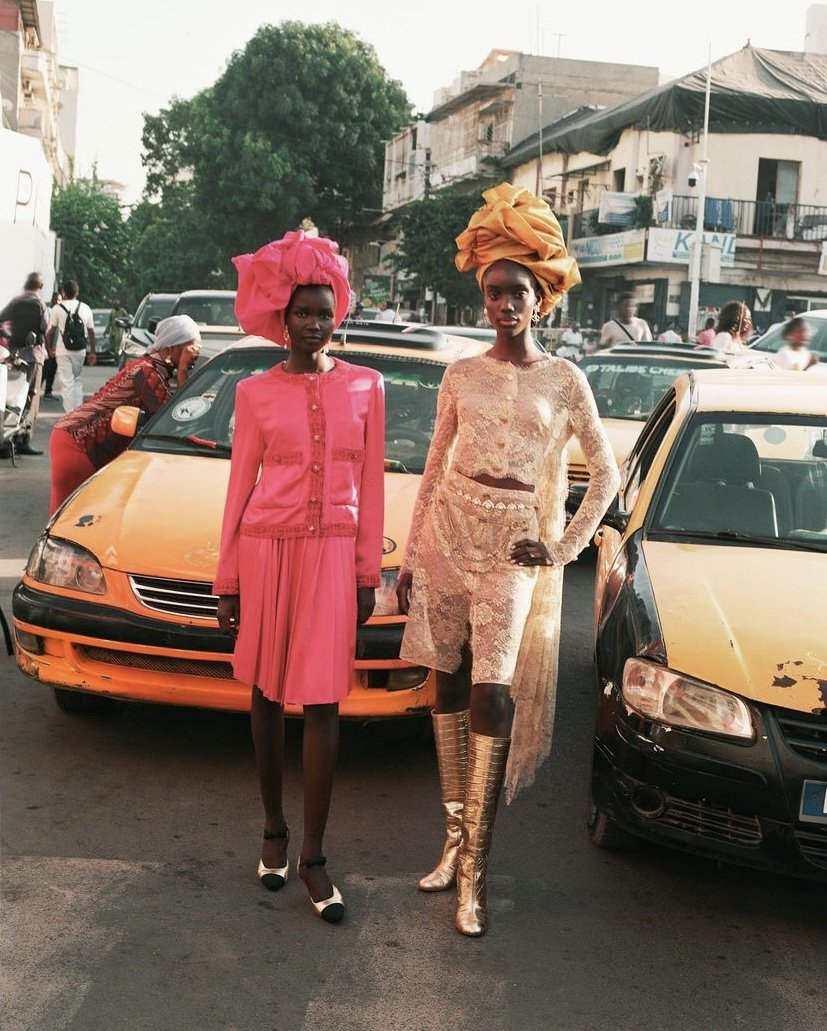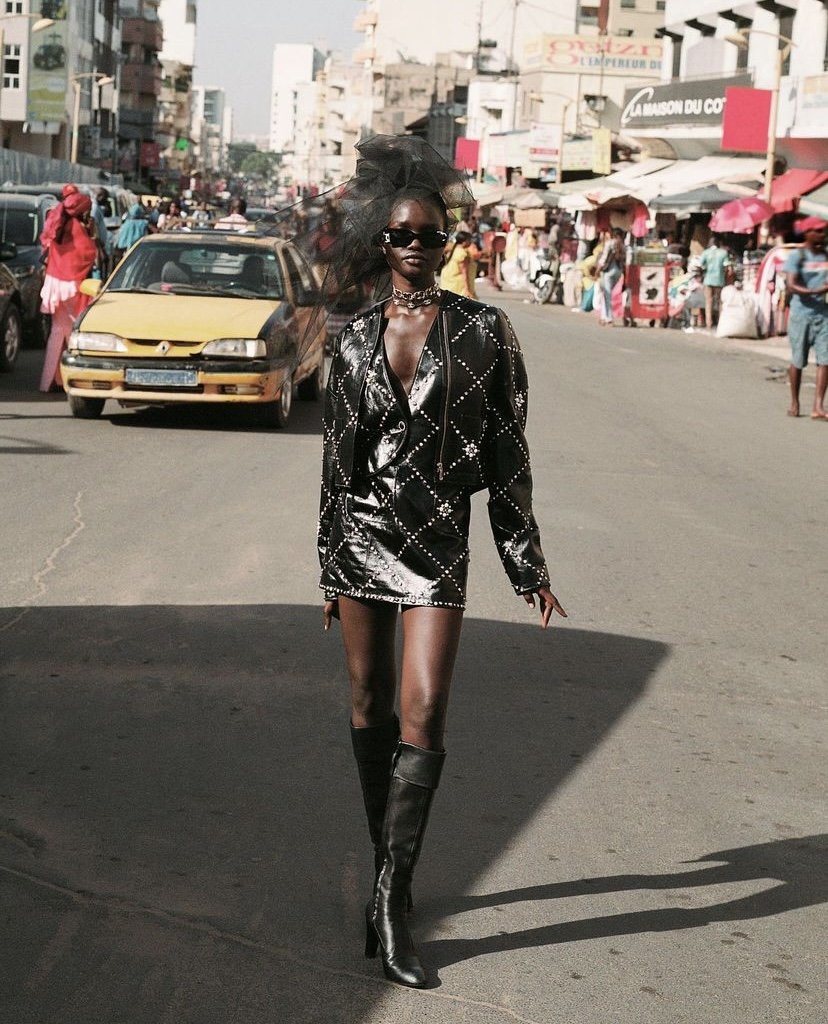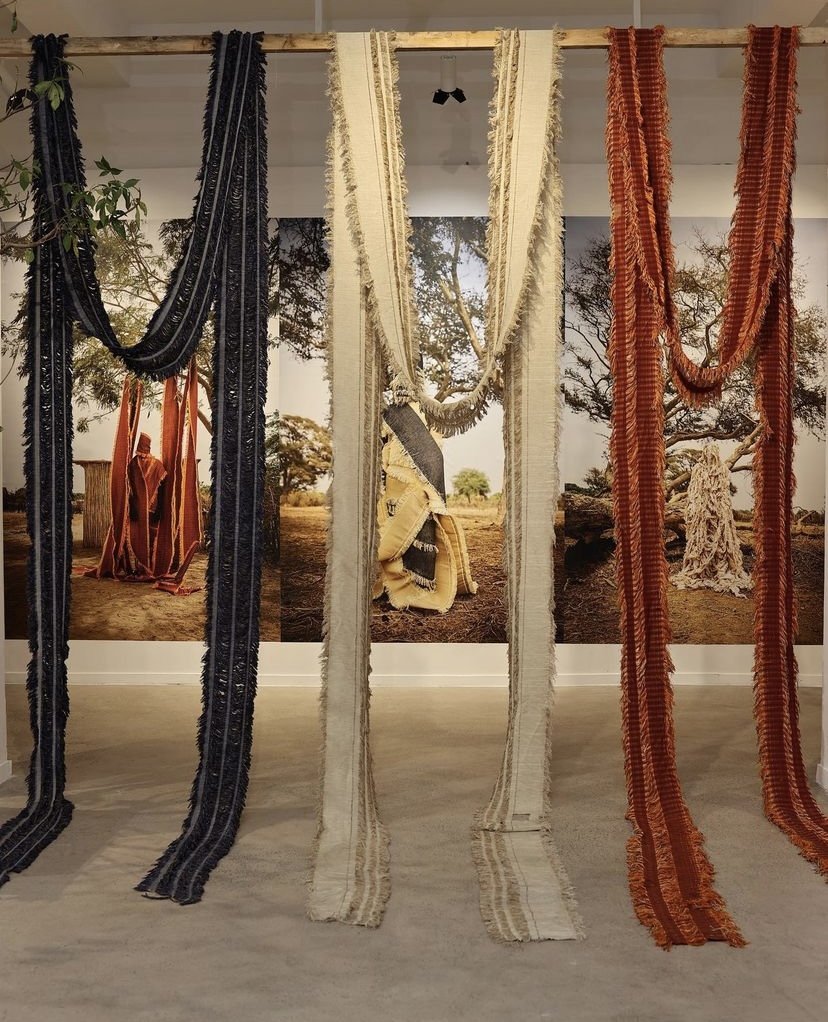Chanel surprised everyone last year, when they showed their Métiers d’Art 2022/23 collection in Dakar, Senegal. It was the first ever show the French brand has done in sub-Saharan Africa. The move from the storied fashion house could be surprising given the driving forces in the luxury category on the continent which, according to Statista, are South Africa and Nigeria. This year, the two countries boasted $783 million and $459 million in revenue so far in the luxury goods market category. Meanwhile, with almost 17 million inhabitants and $141 million in luxury goods market revenue, Senegal on first glance looks like a relatively small market to dive into.
Editorial for Chanel Métiers d’Art styled by Lejenke Ahmed Tailly, shot by Malick Bodian.
Left: Models Akon Changkou and Maty Fall Diba. Right: Model Akon Changkou.
Dakar, a unique fashion capital
But Dakar, officially the country’s capital since 1960, has followed Saint-Louis – Senegal’s former capital from 1872 to 1957 – as an economic and cultural beacon across Central and West Africa. When pioneer photographer and Saint-Louis native Mama Casset (1908-1992) opened his ‘African Photo’ studio in Dakar’s Médina neighbourhood, besides capturing the ‘dakaroise’ bourgeoisie during a particular era – pre and post-colonial Senegal – he immortalised the essence of style that makes the city a vibrant fashion capital even by today’s standards.
One of the most famous Casset portraits is of a woman gently leaning her face on her crossed hands (below). Her fingers and nails, painted with henna, lead to her face crowned by a beautiful head scarf from which peaks intricate braided hair adorned with jewels. Her dress looks like a traditional boubou enriched with golden brocade which recalls her earrings, bracelets and watch. The black and white picture dated between 1950 and 1970 is definitely of its age. Yet, it perfectly encapsulates this mix of tradition and modernity that distinguishes Dakar. The brocade motif, like the elaborate garments worn by the women and men photographed by Mama Casset, are testimonies of the craftsmanship and tailoring culture that makes Dakar a unique African fashion capital to this day.

Woman in the studio by Mama Casset, circa 1950-1960
Senegal is 95% Muslim, meaning Fridays and festivities such as Eid Al-Adha and Eid Al-Fitr are some of the many occasions for Senegalese to dress up or have an outfit made-to-measure by one of the many tailors of the city. Afterall, fashion and style don’t just happen during Dakar Fashion Week. It is instead a whole year’s business, and above all, it makes clear that fashion, style and craftsmanship run in the capital’s DNA.
Dakar, an attractive fashion capital for Western luxury brands
No wonder brands such as Hugo Boss, Lacoste or Tommy Hilfiger have already opened stores in the city. But, in the case of Chanel, they didn’t come to Dakar to open a store or show a ready-to-wear collection; instead, they tapped into Dakar’s cultural and creative scene.
Launched in 2002 by Karl Lagerfeld, Chanel Métiers d’Art is an initiative born out of the late creative’s will to showcase, highlight and safeguard French craftsmanship. To further its intention, the Chanel group started working as soon as 2016 on le19M, a 25,500 square meters complex based in Paris’ XIXth arrondissement designed to bring together 11 Maisons d’art and 600 artisans.
Exhibition “Sur le fil: Broderie et tissage” presented at Dakar’s Musée Théodore-Monod
Left: Founder of the L’Artisane label Khadija Ba and embroiderers of Ngaye Mékhé village
Right: Installation by visual artist Malick Welli
After it opened in January 2022, the space launched its first international program with le19M Dakar with the exhibition “Sur le fil: broderie et tissage” presented at Dakar’s Musée Théodore-Monod in collaboration with the Institut Fondamental d’Afrique Noire, IFAN (Fundamental Institute of Black Africa) as well as Senegalese artisans and artists showcasing artisanal skills through their work. The Chanel Métiers d’Art show coming to Dakar was another step in the brand’s mission to promote craftsmanship.
Adama Ndiaye, the champion of “Made in Africa by Africans”
Founded by fashion and media mogul Adama Ndiaye, Dakar Fashion Week celebrated its 20th anniversary a couple of days before the Chanel show. Since her beginnings, the designer and businesswoman always chose to champion “Made in Africa by Africans for the World.”
Born in Kinshasa from Senegalese diplomats, she quit a career in banking and has launched a series of initiatives over the past 20 years: her own brand, Adama Paris, fashion events such as Black Fashion Week which travelled the world from Bahia to Montreal and Paris, a fashion TV channel, Fashion Africa Channel, and a concept store called Saargale, to promote her creations and brands from Africa and the diaspora. The multihyphenate entrepreneur is a force to be reckoned with in Senegal, and worldwide. Needless to say, Adama Ndiaye had been championing her message “Made in Africa by Africans for the World” before Chanel set eyes on Senegal.
Une publication partag\u00E9e par Dakar Fashion week (@dakarfashionweek)
“,”description”:{“html”:”
“}}” data-block-type=”22″>
As a result, the French brand relied on her influence and network to produce their show. Despite Western media covering Chanel coming to Senegal as a massive step for the country’s fashion industry, few acknowledged that the French brand’s coming to Dakar was an obvious indicator that craftsmanship and fashion in Senegal and Africa were always present.
From Africa to the world
Apart from Dakar Fashion Week, which started in 2003, it is worth noticing that most fashion events throughout the continent, such as Lagos Fashion Week, Hub of Africa Addis Ababa Fashion Week and Glitz Africa Fashion Week in Ghana, all came to light during the 2010s. This surge of fashion events in different parts of the continent shows there was and is a will to house the industry locally, despite the need for more connections across Africa.
Une publication partag\u00E9e par Lagos Fashion Week (@lagosfashionweekofficial)
“}” data-block-type=”22″>
The 2010s were also a period during which African fashion started to become more global, a point of view shared by Beatrace Angut Oola, fashion curator and founder of the Fashion Africa Now platform and creative agency APYA Productions: “If we look back to 10 to 12 years ago, Barack Obama’s election was one indicator. He and his wife, Michelle Obama, were the first Black couple to lead the USA and represent Blackness.” The then-First Lady wore Black and African designers such as Maki Oh, Mimi Plange or Duro Olowu. “It brought [the designers she wore] media visibility and signalled telling new narratives through fashion.”

Beatrace Angut Oola, founder of the Fashion Africa Now platform, shot here for her recent collaboration with Nigerian fashion brand Nkwo and German shoe brand Wildling
The podcaster behind the show Fashion Africa Now also attributes this global interest in fashion in Africa to Afrobeat; “who would have thought they’ll play Afrobeat in clubs, restaurants and hotels all over the world?” she then continues, “the influence, narrative, aesthetic and impact of this new vibe has taken over the world, and is allowing the African fashion movement to find its way.”
Burna Boy is an example of influence in fashion worldwide. Styled by his stylist and creative director sister Ronami Ogulu, the African Giant wears big names such as Gucci, Prada, Margiela, or Marni but doesn’t hesitate to sport African brands such as Onalaja, Thebe Magugu, Tokyo James or Weiz Dhurm Franklyn alongside. With 14.4 million followers on Instagram and a sold-out show at the London Stadium this year – the first ever headlined by an African – Burna Boy’s musical and stylistic influence is undeniable.
Africa’s fashion challenges won’t stop it from blossoming
Unfortunately, such exposure for African designers isn’t enough and can even be counterproductive. In a BoF interview, designer Thebe Magugu explains, “I think fashion often touts African designers, gives them opportunities to show but doesn’t consider the massive infrastructural rifts. And when things don’t work out, we blame the designer and not the industry.” The South African designer is among the few African designers who has found success worldwide. Yet, despite many challenges, he decided to focus on producing and catering to local customers in his homeland.












